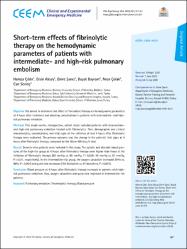Short-term effects of fibrinolytic therapy on the hemodynamic parameters of patients with intermediate- and high-risk pulmonary embolism

View/
Access
info:eu-repo/semantics/openAccesshttp://creativecommons.org/licenses/by-nc/3.0/us/Date
2022Metadata
Show full item recordAbstract
Objective We aimed to determine the effect of fibrinolytic therapy on hemodynamic parameters at 4 hours after treatment and bleeding complications in patients with intermediate- and high-risk pulmonary embolism.
Methods This single-center, retrospective, cohort study included patients with intermediate- and high-risk pulmonary embolism treated with fibrinolytics. Their demographic and clinical characteristics, complications, and vital signs at the initiation of and 4 hours after fibrinolytic therapy were evaluated. The primary outcome was the change in the patients' vital signs at 4 hours after fibrinolytic therapy, compared by the Mann-Whitney U-test.
Results Seventy-nine patients were included in this study. The systolic and diastolic blood pressures of the high-risk group at 4 hours after fibrinolytic therapy were higher than those at the initiation of fibrinolytic therapy (80 mmHg vs. 99 mmHg, P = 0.029; 49 mmHg vs. 67 mmHg, P = 0.011, respectively). In the intermediate-risk group, the oxygen saturation increased (94% vs. 96%, P = 0.004) and pulse rate decreased (104 beats/min vs. 91 beats/min, P < 0.001).
Conclusion Blood pressure at 4 hours after fibrinolytic therapy increased in patients with high-risk pulmonary embolism. Also, oxygen saturation and pulse rate improved in intermediate-risk patients.
Source
Clinical and Experimental Emergency MedicineVolume
9Issue
1Collections
The following license files are associated with this item:


















